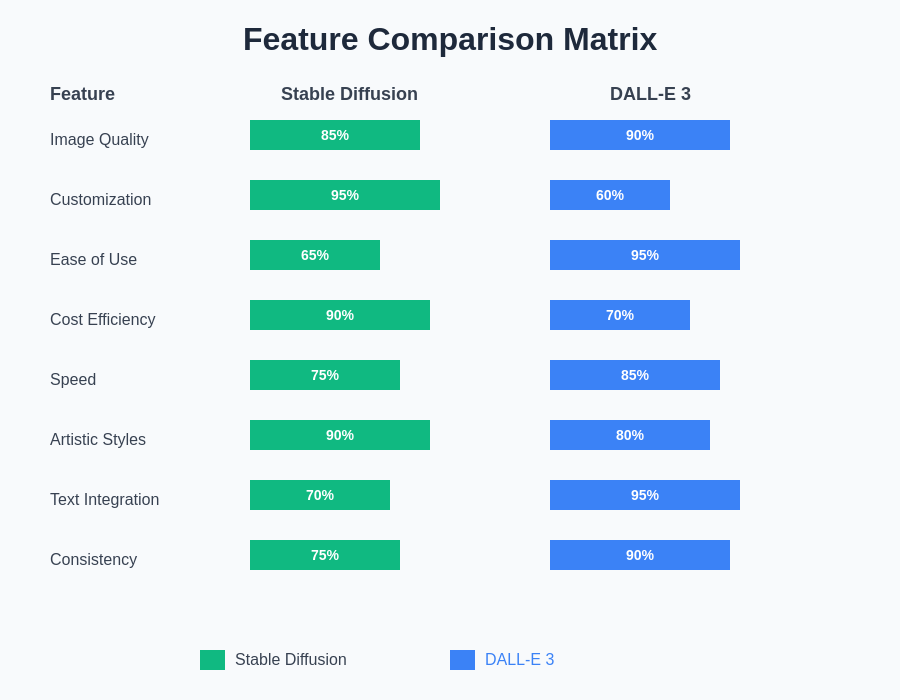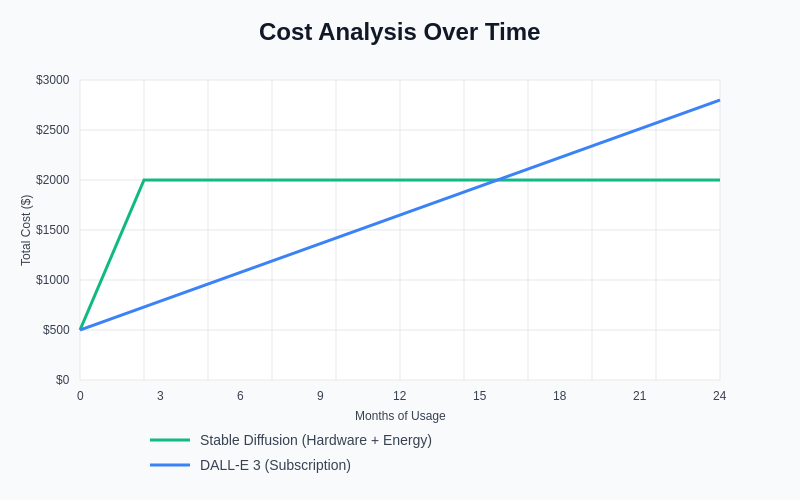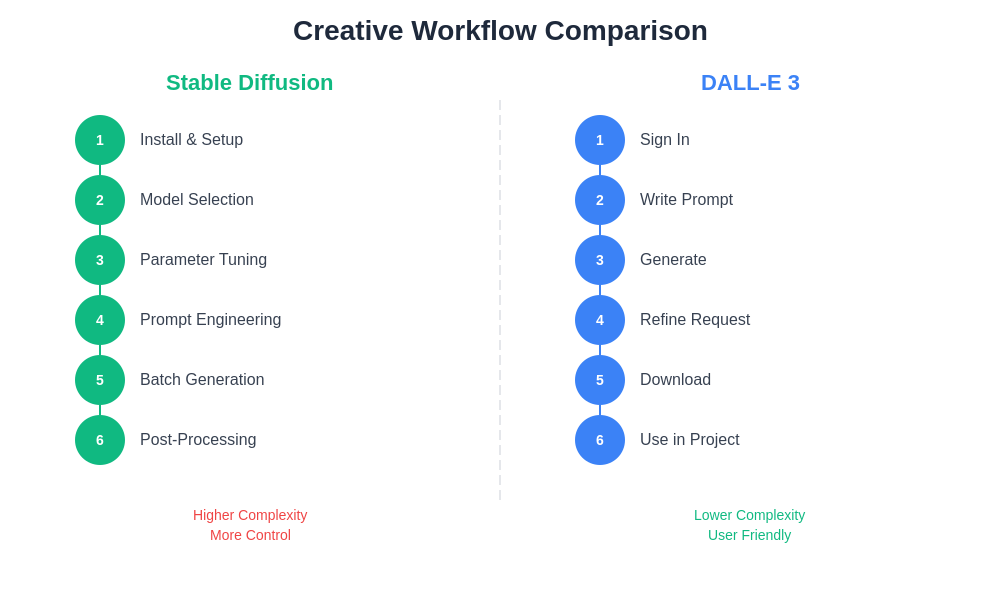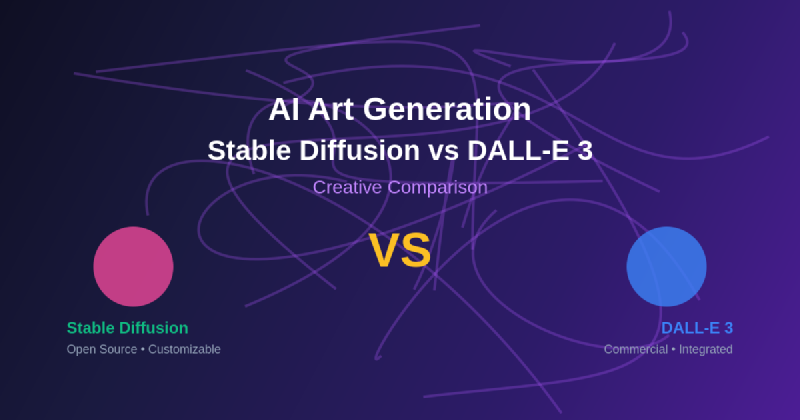The realm of artificial intelligence has revolutionized creative expression through sophisticated art generation technologies, with Stable Diffusion and DALL-E 3 emerging as the most prominent and influential platforms in this rapidly evolving landscape. These groundbreaking systems have fundamentally transformed how artists, designers, and creative professionals approach visual content creation, offering unprecedented capabilities that blur the boundaries between human imagination and machine-generated artistry. The comparison between these two powerful platforms reveals distinct philosophical approaches to AI-assisted creativity, each offering unique advantages and capabilities that cater to different creative needs and artistic visions.
Explore the latest AI art trends and techniques to discover cutting-edge developments that are reshaping the creative industry and inspiring new forms of artistic expression. The emergence of these sophisticated AI art generators represents more than technological advancement; it signifies a fundamental shift in how creative content is conceived, developed, and refined in the digital age.
Understanding AI Art Generation Technology
The foundation of modern AI art generation rests upon complex neural network architectures that have been trained on vast datasets of images and textual descriptions, enabling these systems to understand and interpret the relationship between written prompts and visual representations. Both Stable Diffusion and DALL-E 3 utilize diffusion models, a sophisticated approach to image generation that begins with random noise and gradually refines it into coherent, detailed artwork through iterative processes guided by learned patterns and associations from their training data.
The technological sophistication underlying these platforms involves multiple layers of machine learning algorithms working in concert to translate abstract concepts and specific descriptions into visually compelling artwork. This process involves understanding semantic relationships, artistic styles, compositional principles, and visual aesthetics in ways that often produce results that rival or exceed traditional artistic methods in both speed and creative variety. The ability of these systems to generate original artwork from textual descriptions has opened new possibilities for creative expression while raising important questions about the nature of creativity, authorship, and artistic value in the digital era.
Stable Diffusion: Open Source Creative Freedom
Stable Diffusion distinguishes itself in the AI art generation landscape through its open-source architecture and community-driven development model, providing artists and developers with unprecedented access to the underlying technology that powers AI art creation. This accessibility has fostered a vibrant ecosystem of modifications, customizations, and specialized applications that extend far beyond the original platform’s capabilities. The open-source nature of Stable Diffusion has enabled researchers, artists, and developers to create specialized models trained on specific artistic styles, subjects, or aesthetic approaches, resulting in a diverse array of tools tailored to particular creative needs.
The flexibility inherent in Stable Diffusion’s architecture allows for extensive customization and fine-tuning, enabling users to train models on their own datasets or modify existing models to achieve specific artistic effects. This adaptability has led to the development of specialized versions optimized for particular artistic styles, from photorealistic portraits to abstract compositions, anime-style illustrations, and architectural visualizations. The community surrounding Stable Diffusion has created an extensive library of pre-trained models, plugins, and tools that enhance the platform’s capabilities while maintaining the core principle of accessible, democratized AI art generation.
Experience advanced AI creativity with Claude for sophisticated artistic projects that require nuanced understanding and creative collaboration between human vision and artificial intelligence capabilities. The integration of multiple AI tools creates a powerful creative workflow that combines the strengths of different platforms to achieve superior artistic outcomes.
DALL-E 3: Commercial Excellence and Integration
DALL-E 3 represents OpenAI’s commercial approach to AI art generation, emphasizing user experience, safety, and seamless integration with existing creative workflows and platforms. The platform’s development prioritizes consistency, reliability, and ease of use, making it particularly attractive to professional creators and businesses seeking dependable AI art generation capabilities without the technical complexity often associated with open-source alternatives. The sophisticated training and fine-tuning processes employed in DALL-E 3’s development have resulted in exceptional image quality and prompt interpretation accuracy.
The commercial nature of DALL-E 3 has enabled significant investment in research and development, resulting in advanced features such as improved text rendering within images, better understanding of complex compositional requirements, and enhanced ability to maintain stylistic consistency across multiple generated images. The platform’s integration with ChatGPT and other OpenAI services creates a seamless creative workflow that allows users to iteratively refine their artistic vision through conversational interaction, making the art generation process more intuitive and accessible to users without extensive technical backgrounds.
The emphasis on safety and content moderation within DALL-E 3 ensures that generated artwork adheres to community guidelines and ethical standards, making it suitable for professional and commercial applications where content compliance is essential. This approach to responsible AI art generation has established DALL-E 3 as a trusted platform for businesses and creators who require reliable, appropriate content generation capabilities.
Creative Quality and Artistic Capabilities
The comparison of creative output between Stable Diffusion and DALL-E 3 reveals distinct strengths and characteristics that appeal to different artistic preferences and professional requirements. Stable Diffusion excels in producing highly detailed, technically proficient artwork with particular strength in specific domains where specialized models have been developed and refined by the community. The platform’s ability to generate extremely high-resolution images with intricate details makes it particularly valuable for applications requiring technical precision or specific artistic styles.
DALL-E 3 demonstrates superior performance in prompt interpretation and compositional coherence, often producing images that more accurately reflect the nuanced intentions expressed in textual descriptions. The platform’s strength lies in its ability to understand complex relationships between objects, maintain consistent lighting and perspective, and generate images that feel cohesive and professionally composed. The quality of text integration within images and the accuracy of specific object placement and interaction represent areas where DALL-E 3 often outperforms its competitors.
Both platforms excel in different aspects of creative generation, with Stable Diffusion offering greater flexibility for experimental and unconventional artistic approaches, while DALL-E 3 provides more consistent results for traditional artistic and commercial applications. The choice between platforms often depends on the specific creative requirements, desired level of control, and intended application of the generated artwork.
Accessibility and User Experience Design
The user experience design philosophies of Stable Diffusion and DALL-E 3 reflect their different approaches to AI art generation, with each platform optimizing for distinct user types and creative workflows. Stable Diffusion’s open-source nature means that the user experience varies significantly depending on the interface and implementation being used, ranging from command-line interfaces for technical users to sophisticated graphical applications designed for artists and designers. This flexibility allows users to choose interfaces that match their technical expertise and creative preferences.
DALL-E 3’s commercial development has resulted in a polished, consistent user experience designed to minimize technical barriers while maximizing creative potential. The platform’s integration with familiar interfaces and its intuitive prompt-based interaction model make it accessible to users with varying levels of technical expertise. The emphasis on user experience design has resulted in features such as iterative refinement, style consistency, and seamless integration with creative workflows that enhance productivity and creative satisfaction.
Enhance your research capabilities with Perplexity for comprehensive analysis and creative inspiration that informs your AI art generation projects with relevant context and artistic references. The combination of research tools and generation platforms creates a more informed and intentional creative process.
Technical Performance and Resource Requirements
The technical performance characteristics of Stable Diffusion and DALL-E 3 reflect their different architectural approaches and deployment models, with significant implications for users considering factors such as cost, speed, and resource requirements. Stable Diffusion’s open-source nature allows for local deployment on consumer hardware, providing users with complete control over their creative process while eliminating ongoing subscription costs. However, this local deployment requires significant computational resources, particularly GPU memory and processing power, which can limit accessibility for users without high-end hardware.
The optimization and efficiency of local Stable Diffusion implementations vary significantly based on hardware configuration, software optimization, and model selection. Advanced users can achieve impressive performance through careful optimization and hardware selection, while casual users may find the technical requirements challenging. The ability to run Stable Diffusion locally provides advantages in terms of privacy, unlimited generation capacity, and freedom from internet connectivity requirements.
DALL-E 3’s cloud-based architecture eliminates local hardware requirements while providing consistent performance across different devices and platforms. The commercial nature of the service means that computational resources are professionally managed and optimized, resulting in predictable performance and availability. However, this approach requires ongoing subscription costs and internet connectivity, while limiting the total number of generations available to users based on their subscription tier.
Customization and Creative Control Options
The level of customization and creative control available in each platform reflects their fundamental design philosophies and target audiences, with Stable Diffusion offering extensive modification capabilities while DALL-E 3 focuses on intuitive control through natural language interaction. Stable Diffusion’s open-source architecture enables deep customization through model training, fine-tuning, and modification of generation parameters. Advanced users can create specialized models optimized for specific artistic styles, subjects, or aesthetic approaches, resulting in highly personalized creative tools.
The availability of numerous third-party interfaces, plugins, and extensions for Stable Diffusion provides users with sophisticated control over every aspect of the generation process, from initial composition through final refinement. Features such as inpainting, outpainting, image-to-image translation, and style transfer offer comprehensive creative control that enables precise artistic vision realization. The ability to combine multiple models and techniques within a single workflow provides unprecedented flexibility for complex creative projects.

The comprehensive feature analysis reveals distinct strengths and capabilities that differentiate these platforms across critical performance dimensions. While both systems excel in their respective areas, the comparison highlights how architectural differences translate into practical advantages for different types of creative applications and user preferences.
DALL-E 3’s approach to creative control emphasizes intuitive interaction through conversational prompting and iterative refinement rather than technical parameter manipulation. The platform’s sophisticated prompt interpretation capabilities allow users to achieve precise creative results through detailed textual descriptions, making advanced creative control accessible to users without technical expertise. The integration with ChatGPT enables iterative refinement and collaborative creative development that feels natural and intuitive.
Cost Considerations and Economic Models
The economic models underlying Stable Diffusion and DALL-E 3 present fundamentally different approaches to AI art generation costs, each with distinct advantages and limitations depending on user needs and usage patterns. Stable Diffusion’s open-source nature eliminates direct software costs, requiring only the initial investment in compatible hardware and ongoing electricity costs for local generation. This model provides unlimited generation capacity once the initial setup is complete, making it particularly attractive for high-volume users and commercial applications.
The total cost of ownership for Stable Diffusion includes hardware acquisition, maintenance, and upgrade costs, which can be significant for users seeking optimal performance. However, the one-time nature of these costs and the unlimited generation capacity can result in lower long-term costs for active users. The availability of cloud-based Stable Diffusion services provides alternative cost structures that balance the benefits of the open-source model with the convenience of managed services.
DALL-E 3’s subscription-based model provides predictable costs with no upfront hardware investment, making it accessible to users who prefer operational expenses over capital expenditure. The tiered pricing structure allows users to select appropriate service levels based on their generation volume and feature requirements. While ongoing subscription costs may exceed the long-term costs of local Stable Diffusion deployment for high-volume users, the convenience and reliability of the managed service provide value that justifies the expense for many users.

The long-term cost implications reveal significantly different financial trajectories for each platform, with Stable Diffusion requiring higher initial investment but offering unlimited generation capacity, while DALL-E 3 provides lower entry barriers with predictable ongoing operational costs that may compound over extended usage periods.
Integration with Creative Workflows
The integration capabilities of both platforms with existing creative workflows and professional tools significantly influence their practical utility for artists, designers, and content creators working within established production pipelines. Stable Diffusion’s open-source architecture and extensive API support enable seamless integration with a wide variety of creative software, from professional design applications to custom workflow automation systems. The availability of plugins and extensions for popular creative tools makes Stable Diffusion a natural fit for existing creative workflows.
The flexibility of Stable Diffusion’s output formats and the ability to customize generation parameters makes it particularly suitable for integration with professional workflows that require specific technical specifications or creative control levels. The platform’s batch processing capabilities and automation potential enable efficient production workflows that can generate large volumes of creative content with consistent quality and style characteristics.
DALL-E 3’s integration approach focuses on user-friendly interfaces and seamless connectivity with OpenAI’s ecosystem of tools and services. The platform’s emphasis on conversational interaction and iterative refinement makes it particularly suitable for creative workflows that benefit from collaborative development and iterative improvement. The integration with ChatGPT creates unique opportunities for creative briefing, concept development, and artistic direction that enhance the overall creative process.

The workflow analysis demonstrates how different platform architectures create distinctly different user experiences, with Stable Diffusion offering more technical control steps while DALL-E 3 emphasizes streamlined, intuitive processes that reduce complexity while potentially limiting advanced customization options.
Community and Ecosystem Development
The community ecosystems surrounding Stable Diffusion and DALL-E 3 reflect their different development models and philosophies, each fostering distinct types of innovation and collaboration within the AI art generation space. The Stable Diffusion community has developed into a vibrant, diverse ecosystem of developers, artists, and researchers who contribute to the platform’s ongoing evolution through model development, tool creation, and knowledge sharing. This collaborative environment has resulted in rapid innovation and specialization that extends the platform’s capabilities far beyond its original scope.
The open-source nature of Stable Diffusion has enabled the development of specialized communities focused on particular artistic styles, technical applications, or creative approaches. These communities share models, techniques, and resources that benefit the entire ecosystem while fostering innovation and experimentation. The collaborative development model has resulted in faster feature development and more diverse capabilities than would be possible through centralized development alone.
DALL-E 3’s community development occurs within the structured environment of OpenAI’s platform and services, focusing on user education, creative inspiration, and best practice sharing. The commercial nature of the platform creates a different type of community dynamic, with emphasis on user support, creative showcases, and professional application rather than technical development and modification. This approach provides stability and reliability while limiting the type of community-driven innovation characteristic of open-source platforms.
Future Development and Innovation Trajectories
The future development paths for Stable Diffusion and DALL-E 3 are shaped by their fundamental architectural and philosophical differences, suggesting divergent evolution trajectories that will continue to differentiate these platforms in terms of capabilities, applications, and target audiences. Stable Diffusion’s open-source development model enables rapid experimentation and innovation driven by community needs and interests, likely resulting in continued specialization and diversification of capabilities across different artistic domains and technical applications.
The distributed development model of Stable Diffusion suggests that future innovations will emerge from the community’s diverse interests and requirements, potentially leading to breakthrough developments in areas such as real-time generation, specialized artistic applications, and novel creative workflows. The platform’s flexibility and adaptability position it well for incorporation of emerging technologies and creative techniques as they develop.
DALL-E 3’s commercial development approach suggests continued focus on user experience improvements, integration enhancements, and capabilities that serve professional and commercial creative applications. The substantial research and development resources available to OpenAI enable systematic advancement in areas such as prompt interpretation, image quality, and safety features that benefit the platform’s target audience of professional creators and businesses.
The evolution of both platforms will likely be influenced by broader trends in AI development, including advances in model architecture, training methodologies, and computational efficiency. The different development models of these platforms ensure that the AI art generation landscape will continue to offer diverse options that serve different creative needs and preferences while pushing the boundaries of what is possible in AI-assisted creativity.
Conclusion and Creative Recommendations
The comparison between Stable Diffusion and DALL-E 3 reveals that both platforms offer compelling advantages for different types of creative applications and user preferences, making the choice between them dependent on specific requirements, technical capabilities, and creative objectives. Stable Diffusion’s open-source flexibility and community-driven innovation make it ideal for users who value customization, unlimited generation capacity, and the ability to develop specialized creative tools. The platform’s strength lies in its adaptability and the creative potential unlocked by its extensive customization capabilities.
DALL-E 3’s commercial polish and user experience focus make it particularly suitable for professional creators and businesses who prioritize reliability, ease of use, and integration with existing creative workflows. The platform’s sophisticated prompt interpretation and consistent quality make it an excellent choice for users who prefer intuitive creative control over technical customization options.
The future of AI art generation will likely benefit from the continued development of both approaches, with open-source innovation driving experimentation and specialization while commercial platforms ensure reliability and professional-grade capabilities. The diversity of options available to creative professionals enables selection of tools that best match their specific needs, creative vision, and workflow requirements, ultimately advancing the entire field of AI-assisted creativity.
Disclaimer
This article is for informational purposes only and does not constitute professional advice. The comparison is based on publicly available information and general user experiences with both platforms. Individual results may vary depending on specific use cases, technical configurations, and creative requirements. Readers should evaluate both platforms based on their specific needs and requirements before making decisions about creative tool selection.
